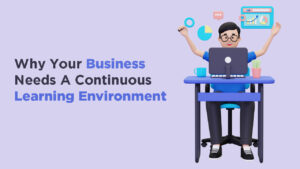The rapid advancement of technology has transformed workplace learning, enabling organizations to provide employees with innovative, flexible, and engaging training solutions. As corporate work culture shifts toward remote and on-the-go learning, companies must ensure their sales teams have access to effective training programs that enhance their skills and performance.
For sales representatives, who are often on the move meeting clients and closing deals, traditional training methods can be ineffective and impractical. Even lengthy eLearning courses can be challenging to integrate into their demanding schedules. To address these challenges, organizations are increasingly adopting mobile learning (mLearning)—a cost-effective, versatile, and accessible training solution that empowers sales professionals to learn anytime, anywhere.
mLearning delivers bite-sized, interactive content in multiple formats, including videos, podcasts, quizzes, gamified modules, infographics, and microlearning courses. Before implementing mobile learning, organizations must evaluate their needs and objectives. However, the benefits of mobile learning for sales training are undeniable.
Key Benefits of Mobile Learning for Sales Training
1. Multi-Device Accessibility for Seamless Learning
Mobile learning provides multi-device compatibility, allowing employees to access training materials across various devices, including smartphones and tablets. Given the increasing use of mobile technology in the workplace, on-the-go learning is no longer a luxury—it’s a necessity.
✅ Ensures flexibility, allowing sales representatives to complete training on their preferred devices.
✅ Increases course completion rates by providing accessible learning opportunities.
✅ Enhances convenience, ensuring that learning fits into a busy sales schedule.
2. Just-in-Time Learning for On-Demand Support
Sales professionals often need quick access to crucial information before client meetings or sales pitches. Mobile learning enables them to retrieve real-time, bite-sized training materials at their moment of need, enhancing their confidence and preparedness.
✅ Provides quick access to product details, customer insights, and sales techniques.
✅ Reinforces learning through short, focused training modules.
✅ Eliminates delays in receiving important updates and feedback.
3. Increased Employee Engagement Through Interactive Learning
Traditional training methods struggle to engage busy sales professionals, but mobile learning encourages active participation through interactive content. Organizations can incorporate elements such as videos, animations, gamification, and simulations to create engaging, immersive learning experiences.
✅ Offers short, engaging training nuggets that align with employees’ fast-paced schedules.
✅ Encourages self-paced learning, enabling employees to train whenever and wherever they choose.
✅ Provides gamification features (badges, leaderboards, quizzes) to increase motivation.
4. Personalized Learning for a Tailored Training Experience
Personalized learning paths enable employees to focus on relevant content, improving knowledge retention and application. With learner-specific dashboards and AI-driven recommendations, mobile learning adapts to each individual’s progress, strengths, and knowledge gaps.
✅ Customizes learning content based on individual needs and performance.
✅ Provides progress tracking dashboards, allowing employees to monitor their development.
✅ Delivers targeted training, ensuring sales reps acquire the right skills at the right time.
5. Enhanced Collaboration and Knowledge Sharing
Mobile learning fosters collaborative learning environments, enabling sales teams to connect, share insights, and learn from each other—no matter where they are. Through discussion forums, chat features, and online mentorship, employees can exchange knowledge and experiences in real time.
✅ Encourages peer-to-peer learning through social discussions and group activities.
✅ Provides instant access to mentors, managers, and sales leaders for guidance.
✅ Supports knowledge-sharing through mobile chat, discussion boards, and SMS updates.
6. Higher Completion and Retention Rates
mLearning delivers training in microlearning formats, which improves knowledge retention and course completion rates. Sales representatives—who often struggle with lengthy training sessions—find digestible, focused content more engaging and effective.
✅ Improves information retention with concise, focused learning modules.
✅ Enhances performance by ensuring sales reps apply what they learn in real-world situations.
✅ Makes learners accountable for their own training progress, encouraging continuous development.
Conclusion
As mobile devices become the primary tool for content consumption, mobile learning is emerging as the go-to solution for modern sales training. By integrating mLearning into their training strategies, organizations can:
✔ Reduce training costs, time, and logistical challenges associated with traditional methods.
✔ Improve knowledge retention and skill application through interactive, engaging content.
✔ Provide real-time learning support, boosting sales representatives’ performance.
✔ Empower employees with flexible, personalized learning experiences.
Mobile learning is redefining sales training, enabling organizations to develop highly skilled, well-equipped, and confident sales teams. Start transforming your sales training strategy today with mobile learning solutions!






